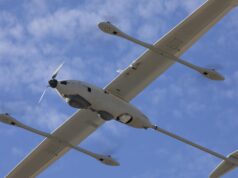The UK government has reaffirmed its commitment to improving defences against the growing threat of hypersonic missiles, according to a new statement from the Ministry of Defence.
Responding to a Parliamentary Question from Andrew Rosindell MP (Conservative – Romford) on 28 April, Minister of State for Defence Maria Eagle outlined the steps being taken to address the evolving missile threat.
“The UK continually reviews its approach to evolving threats, including hypersonic missiles, as part of wider plans for Integrated Air and Missile Defence (IAMD),” she said. “We mitigate air and missile threats through a spectrum of activities including counter proliferation, arms control and deterrence as well as active and passive defences.”
Ms Eagle made clear that international co-operation is central to the UK’s response. “Allied co-operation is key to addressing advanced threats and we are working with the USA and Australia on this topic through the AUKUS framework,” she explained. The trilateral AUKUS agreement has expanded into areas such as advanced defence technologies beyond its initial focus on nuclear-powered submarines.
Alongside partnership efforts, the UK is also investing in new defensive capabilities. “We are investing in developing future defensive capabilities of tomorrow through our defence science and technology portfolio,” the Minister confirmed.
She added that “additional measures are under consideration as part of the Strategic Defence Review,” hinting that further initiatives to bolster Britain’s missile defence network may be announced in the coming months.
Britain and US test engine for new hypersonic cruise missile
Recently, we reported that the United Kingdom is accelerating its efforts to develop a homegrown hypersonic missile, aiming to keep pace with global powers like China, Russia, and the United States. The goal is to have the missile operational by 2030 as part of a broader strategy to bolster the country’s defence capabilities.
In a recent update, Lord Coaker, Minister of State for the Ministry of Defence, outlined the UK’s progress in hypersonic technology, highlighting the nation’s leadership role in this critical area. “The UK is demonstrating its leadership in the global hypersonic arena by active participation in the AUKUS Pillar 2 Advanced Capability Partnership,” he said. The UK has been a key player in advancing capability development alongside its AUKUS allies since the initiative began in 2022.
The Ministry of Defence has established a dedicated programme team, known as Team Hypersonics (UK), to focus on creating a sovereign hypersonic capability.
“Building on previous research and development, the MOD has established a Programme Team – Team Hypersonics (UK) – to cohere Ministry of Defence, industry and academia around the development of a sovereign hypersonic capability,” Coaker explained.
Central to this effort is the Hypersonic Technologies and Capability Development Framework (HTCDF), a £1 billion initiative designed to support the phased development of this cutting-edge technology. “Team Hypersonics (UK) has established the Hypersonic Technologies and Capability Development Framework (HTCDF),” Coaker said, adding that the framework involves 90 suppliers, including defence contractors, small and medium enterprises (SMEs), and academic institutions.
The UK’s hypersonic missile is expected to reach speeds of over Mach 5—five times the speed of sound—enabling it to potentially evade modern air defence systems due to its speed and manoeuvrability. This development is seen as crucial for maintaining the UK’s strategic deterrence in an increasingly competitive global security landscape.
Coaker also noted that testing of key technologies, such as a new hypersonic propulsion system, is already underway.
“With these enablers in place, the testing of critical sovereign-designed and manufactured missile sub-system technologies continues, including a novel hypersonic propulsion system,” he said. Several invitations to tender have been issued to further develop these technologies, paving the way for technical demonstrators and eventually a fully operational missile.
While the exact launch platform for the hypersonic missile has yet to be determined, options include deployment from land, fighter jets, or warships.
The Ministry of Defence has provided few details due to the sensitive nature of the project, but a spokesperson confirmed, “We are pursuing hypersonic technologies to further develop UK sovereign advanced capabilities. We continue to invest in our equipment to meet current and future threats.”














Interesting that Rocketlab is to be utilised, in using its current rocket technology adaptations of Electron for testing of both uk and us hypersonic vehicles. Gives me more confidence in the process I have to say.
It’s strange that European cooperation isn’t mentioned, given that there are multiple European efforts to develop land and naval based interceptor options for hypersonic and ballistic defence, whereas AUKUS options have so far been limited to statements of intent.
That last bit is not necessarily true, even if it’s all somewhat still obscure at the moment, so difficult to be sure what’s talk and what’s solid and how much of each is pure speculation however it’s presented. But at least one source has suggested the recent hypersonic engine tests (so real activity) in the US are related to AUKUS cooperation, seems logical especially in relation to the combined RocketLab link. But obviously this is as far as we know related to offensive hypersonic missiles not anti hypersonic defences as is the core in this thread.
To be fair we often get people on here complaining about too many announcements from Govt the most recent expressed here being on electro magnetic drone technologies a few weeks back, so seems good on this more sensitive technology that little concrete is being released. But it’s worth noting we knew nothing of the scramjet tests until they were completed so I’m sure a lot more is happening beyond statements of intent. Let’s just hope Hegseth is being kept in the dark especially while he’s in the Bourbon aisle.
Absolutely, there are offensive initiatives ongoing in the AUKUS framework.
However, there have been no announced defensive efforts, and frankly, I’d rather see defensive counter-hypersonic research and procurement before money is invested into offensive systems.
I’m so glad we have re affirmed our commitment to possibly researching future developments in the field of hypersonic weapons, hopefully we can get some interesting sounding Greek classical names and a few four letter acronym programs on the go to keep the staff officers busy and maybe look to actually buying something in the post 2050 time frame.
But as I have mentioned above there has been at least some solid developments and testing, indeed in previous threads you have actually commented on them.
Is this defence firms just making money as hypersonic has to agree with laws of physics. Very unconvinced this will work but Putin is doing good job of scaring the west with these supposed hypersonic missiles.
Depends how you field and design the weapon. If you are trying to develop an engine for a hypersonic cruise missile, do you go with the tried and tested Ramjet, but acknowledge your top speed will be around Mach 6/7 and under. Or go for a SCRAMJET, which are known for being grenades and difficult to model correctly. But ultimately try to achieve speeds above Mach 6 nudging on Mach 10? Bearing in mind for a hypersonic cruise missile to operate efficiently, they need to fly above 100,000ft. Where the air is thinner, so there’s significantly less aerodynamic drag.
The benefits of a hypersonic cruise missile over a subsonic or even a supersonic version. is purely down to the reduced time to target. Reducing the time for an enemy’s defences to react, or even blasting past their defences based on speed, is a false narrative. A powered missile no matter how fast its going will not be able to outrun the speed of light (in the atmosphere) as in a radar reflection. It’s just that the radar’s software needs to be programmed to look for and track objects moving that fast. Similarly for a surface to air system to work out the interception, using a slower missile. The system “just” needs to work out the along track velocity of the target, the bearing it is heading and its altitude. Then work out based on the performance of its intercepting missiles, the lead it gives for the interception point.
The speed is a factor that needs to be considered for defence. As you will need to make sure your surveillance assets are covering the likely approaches. But also more crucially have sufficient SAM systems in place to cover the predicted interception umbrella. As a hypersonic weapon will reduce the size of the area such a system can cover, due to the interception window reducing as the hypersonic missile gets closer.
It’s great to see investment in this field but the uk badly needs defence against all kinds of missiles including ballistic. We should be protecting our defence sites and our large cities
With all this R & D into hypersonic will any of this technology feed into future GBAD ABM SAMs and even Air-to-air missiles like Meteor to give them more zip and range?